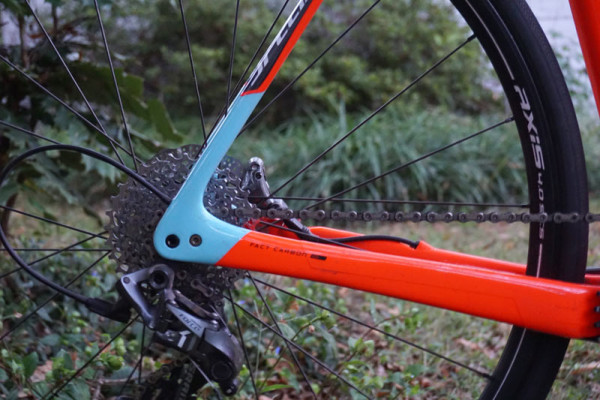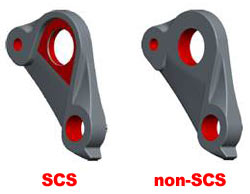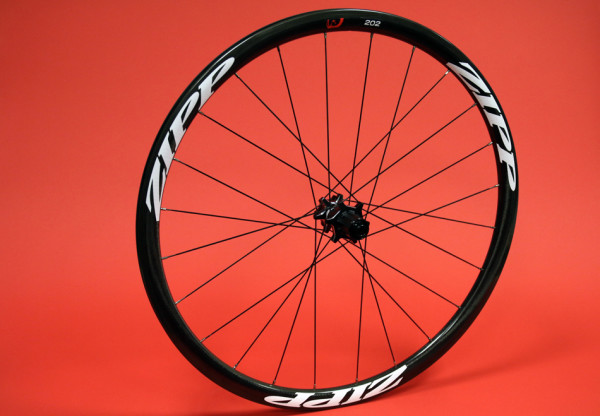The decision to build a bike a certain way is typically made more than a year in advance. Sometimes two or more years. Sometimes there are competing standards or solutions that haven’t been developed yet that need buy in. And sometimes folks are willing to gamble on something they believe in.
In this instance, we’re talking about 12×135 thru axles versus the much more common 12×142.
Think back to HD DVD and Blu-Ray. Both had major brands behind them, and both ended up on the market to let consumers decide. It’s an apt analogy, except in the case of digital movie formats, there was a clear technological winner. Here, after talking to The Big Red S, it’s possible both axle standards could end up playing in garages around the world.
We spoke with Specialized’s Road Brand Manager, Mark Cote, to get the story behind the SCS (Short Chain Stay) disc brake thru axle design. Here’s what he had to say…
“The only two options that existed for thru axles going into this two seasons ago, 135mm and 142mm, and it was looking like 142mm was going to be too wide and cause heel clearance issues. The major reason we went with 135mm is that it worked with all SCS parts in development. It allows us to keep the chainline where it needs to be with chainstays under 420mm. We also didn’t want to change Q-factor on the cranks.”
Specialized first encountered this challenge with the MY2013 Roubaix Disc, which was their first road-going bike with hydraulic disc brakes. It has chainstays that were too short to meet guidelines from SRAM, so they spec’d a wider crankset to get the chainline where it needed to be. And then Cote says they got flak from fitters who complained the Q-factor was too wide. And, it limited the use of other aftermarket cranks already on the market.
The Crux Disc debuted in MY2012 in alloy, and for MY2013 in carbon, both of which used standard 135mm QR dropouts, which was the normal mountain bike standard. These bikes had chainstays longer than 425mm, which technically put them in the allowable spec range, but the chainline wasn’t optimal.
And chainline is a major concern. When road bikes first started getting disc brakes just a few short years ago, we had a long technical discussion with frame and wheel makers about the impact of going from 130mm to 135mm hub spacing. SRAM and Shimano look at a frame’s chainstay length and mandate which cranksets and chainring offsets can be sold to the brand as OEM equipment…they won’t sell them something that doesn’t meet their chainline specifications.
“We had to make the commitment to a thru axle standard about 18 months ago,” says Cote. “Frames were starting to get made in January in order to ship by April, which meant the decision was made around July 2014. At that time, we believed 135mm SCS would be the prevailing standard. We sent drawings of this standard to many frame, wheel and component manufacturers for them to use, royalty free.
“The whole industry is figuring out how to best serve road cyclists. For us, we feel this is the best solution for short chainstay bikes. It wasn’t a solution made just to lock anyone into our wheels.”
In fact, Cote says Fulcrum also makes wheels for SCS, and there’s an open patent out there, which they did so that anyone could use it but no one else could patent it and make it proprietary. Cote says Specialized also has some handshake agreements with other wheel manufacturers that they were hoping would be on the market in time for cyclocross season, but that’s out of their hands.
But, there’s a light at the end of this tunnel. Cotes says a non-SCS thru axle derailleur hanger is coming in November that’ll allow you to run normal 12x135mm thru axle hubs as opposed to 135mm SCS. The part will be free to all riders who purchased a 2016 Crux bike or frameset. And, it’ll allow other wheel manufacturers to easily adapt their wheels to this system by simply creating unique end caps utilizing their existing 135mm hub shells.
Zipp’s ready. Their latest Firecrest carbon 202 and 303 and alloy 30 Course disc brake wheels offer end caps that’ll let their 135mm QR hubs switch to 135mm thru axles. And who doesn’t like Zipp wheels?
For fans of Specialized’s SCS wheels, Cote adds: “We offer five wheelsets ranging from a $250 Axis 4.0 alloy wheelset up to the $2,200 Roval CLX 40 carbon tubulars. And starting in November, we’ll also be offering an Axis hubset with Centerlock and an 11-speed freehub body so you can build your own wheels from it.”
Other options include upcoming wheels from Hope Tech, using a variant of their hubs laced to carbon tubular and clincher rims. Or Next Devo’s adapter kit for DT Swiss hubs.
“At the end of the day, we created a standard that we thought was the right thing for road bikes and decided to use it for our ‘cross bikes, too,” says Cote. “As the entire industry is working towards a standard, we knew we’d learn a lot eventually leading to a committed standard for disc brakes in the industry. All riders committing to new thru axle cross bikes are experiencing compatibility challenges with their older wheels going into this season. This isn’t unique to the 2016 CruX – But you know what? (The Crux) rides amazing, there’s no brake or heel rub issues and the people racing it are really enjoying it.
“Where’s it going in the future? That’s not anything I can speak to right now, but obviously we’re taking all of this feedback into consideration.”



